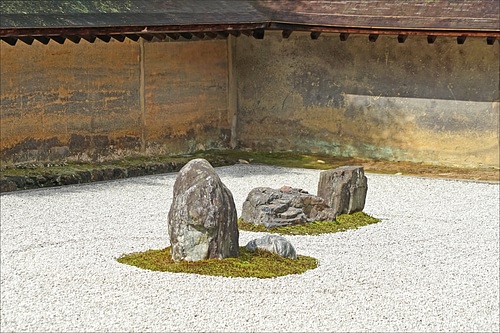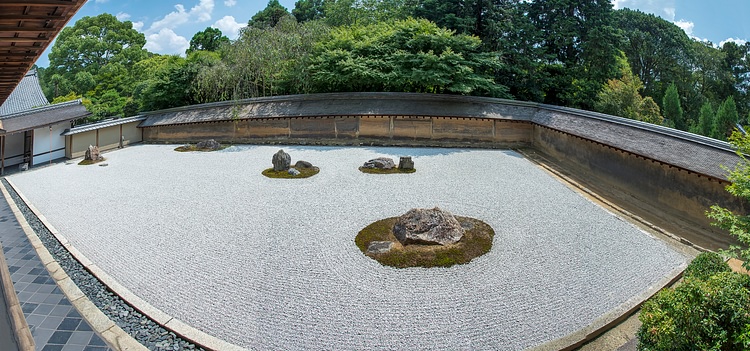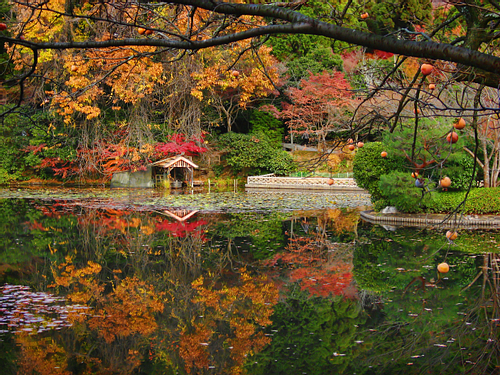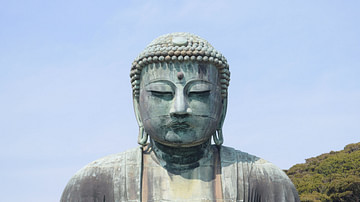
Ryoanji (Ryōan-ji) is a Zen Buddhist temple in Kyoto, Japan which is today most famous for its Zen rock garden with its enigmatic arrangement of stones. Founded in the 15th century CE, the temple is one of the most visited tourist spots in Japan and is listed by UNESCO as a World Heritage Site.
Foundation
The site of Ryoanji, located in the northern hills of Kyoto (Heiankyo) in the district of Ukyo-ku, was converted into a Buddhist temple in 1473 CE. Before that, it was a private estate, created in 1450 CE and owned by the influential Hosokawa family. The gardens were modelled during the ownership of Hosokawa Katsumoto (1430-1473 CE), who retired there, and when the famous general and one of the deputies to the shogun Ashikaga Yoshimasa (r. 1449-1473 CE) died, the buildings were converted for use as a Zen Buddhist temple site.
Zen was introduced to Japan from China in the 12th-13th century CE, and it became especially popular from the mid-15th century CE. Zen thought reduces the significance of studying sacred texts and instead emphasises the importance of contemplation (son) in order to reach enlightenment. Certain things may assist an individual in their process of contemplation and one of these, as we shall see, is the use of minimalist rock gardens.
The Hojo Hall in the complex was once the abbot's residence and its interior is today divided into six rooms by painted sliding screens (fusuma) which include several fine depictions of dragons. There is another building next to the Hojo Hall which is today used as living quarters by the monks of Ryoanji.
Zen Rock Garden
The Zen rock garden of Ryoanji is perhaps the most renowned dry landscape garden (karesansui) in the world and certainly the most visited such garden in Japan. Added to the temple site in the late 15th century CE, its design is usually credited to Soami (aka Shinso, c. 1455-1525 CE), the celebrated landscape garden designer and artist. Soami also designed the famous rock and sand garden at Ginkakuji ('the Silver Pavilion'), also in Kyoto and a mere 15 minutes walk away.
The object of Zen rock gardens is to provide a calm and harmonious environment for contemplation (and so one is not, of course, permitted to actually walk on it and 'disturb' the effect for other onlookers). Just as Japanese landscape paintings often depict subjects that exist only in the imagination so, in reverse, Zen landscapes are real places only in the sense that they exist to promote the imagination.
The rock garden of Ryoanji is of the hira-niwa type, that is, it is completely level and without any trees or plants. It is a rectangular space measuring 31 x 15 metres (102 x 49 ft) and is bordered by a low yellow clay wall on three sides and the wooden verandah of the Hojo Hall on the fourth. The wall, which has a height of 2 metres (6.5 ft), is stained because it is made from clay boiled in natural oils, a particular feature known as wabi-sabi. The walled enclosure, typical of Zen gardens, is designed to remove any distractions away from the garden itself. The garden, however, was likely not enclosed when it was originally made. Within the enclosure, set amongst the always immaculately-raked grey gravel or sand - which is re-formed anew each day - there are 15 stones of various shapes and sizes. Each stone is set on its own small patch of moss and they are so arranged that at no point in the garden can all 15 stones be seen at the same time.
The precise significance of the stones is not known; they may represent mountain peaks protruding from the clouds or islands in the sea or they may merely have been selected and arranged simply for aesthetic reasons. The obvious difference in the size of the rocks may represent the principle of yin and yang. More outlandish theories suggest the stones are laid out in such a way as to promote a specific response in the onlooker's brain as one looks from one rock to another or that the whole thing is a code which refers to a riddle about tiger cubs.
The enigma of the Zen garden may well be intentional - the spot was, after all, designed to provoke meditative reflection. There are some clues, though. The stones are set in groups of three, five and seven, all numbers of significance in Taoism. The trio of stones, with one being larger than the others, may represent the Zen Buddhist triad of the historical Buddha (Shakyamuni) and his two attendants, the bodhisattvas Fugen and Monju. The total number of 15 stones may represent the same day in the lunar calendar which signifies the full moon and which traditionally symbolises both enlightenment and completion in Buddhist thought. The fact that all the stones cannot be seen from a single vantage point consequently carries an extra religious and philosophical significance: one can never see the "complete picture" (Dougill, 2014, p. 54). The garden, then, whatever its meaning, fulfils the three principles of Zen thought in art and architecture: simplicity, suggestion, and irregularity, and certainly achieves the desired symbolism of yugen or 'elegant mystery.'
Additional Garden Features
In addition to the rock garden, there are ponds, moss and landscape gardens reached via pathways which wind through patches of trees of cherry, pine, and camellia. The largest pond garden (actually more like a small lake in dimension), which dates to the 12th century CE, has two islands and on one of these is a small shrine which is considered auspicious as it honours Benten, the spirit of music and creativity. As is typical of Japanese landscape gardens, the pathway around the pond deliberately takes the walker out of sight of the water except at specific viewpoints of which there are seven in this case.
The temple grounds are full of features which remind the visitor of some of the key principles of Buddhism. For example, a small water basin in the north garden, given to the temple in the 17th century CE, takes the form of a Chinese coin and an inscription on it, which can be read both horizontally and vertically, states: 'Learn only satisfaction', i.e. learning should be pursued for its own end and not for money. The water rests in the hole at the centre of the coin and, as the purpose of such basins at temples is to allow visitors to purify themselves, it also has the double-meaning of washing away one's material concerns.
Later History
Once established, the temple gained the patronage of such luminary figures as the daimyo general Toyotomi Hideyoshi (1537-1598 CE) and the shogun Tokugawa Ieyasu (1543-1616 CE). Unfortunately, disaster struck in 1797 CE when a devastating fire destroyed all the buildings at the site. Fortunately, the gardens were largely spared and, in 1800 CE, the temple buildings were rebuilt. Nevertheless, Ryoanji had to wait until the 1930s CE before its popularity really took off and visitors started to flock to see the Zen rock garden. Still a working temple, it is affiliated to the Myoshin-ji School of Rinzai Zen Buddhism. Recently, a traditional tofu restaurant has been added to the site, and Ryoanji continues to attract more visitors and more discussion than any other garden in Japan.
This content was made possible with generous support from the Great Britain Sasakawa Foundation.








